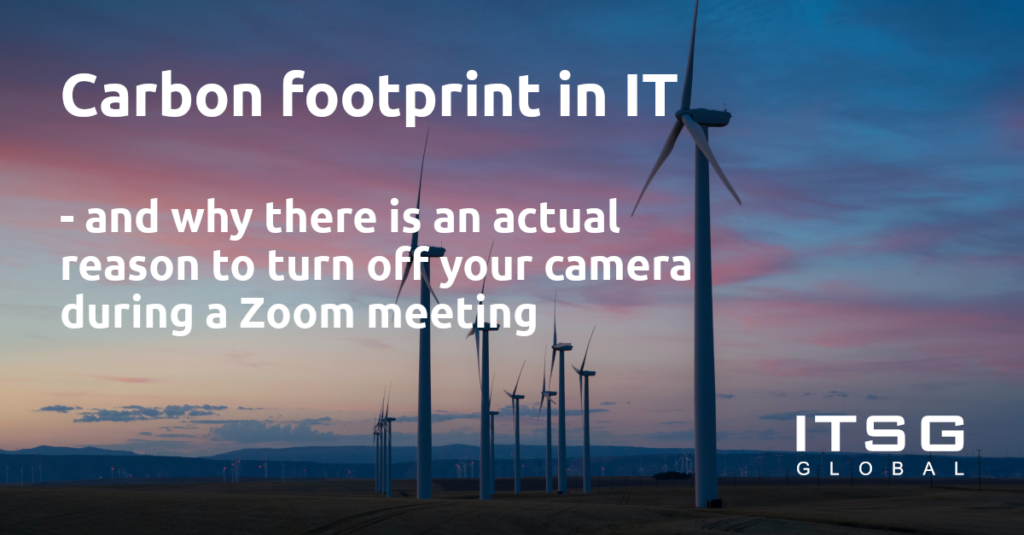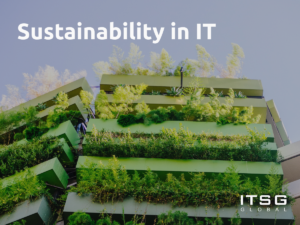6 October 2022

Even though it might look odd to put IT and carbon footprint in one sentence, there are plenty of reasons to do so. The most important one is the demand for non financial reporting – a concept that forces companies to show how sustainable they are. To some extend it can be done by providing vague information on volunteering and CSR initiatives, but in the long run stakeholders will get interested in real data, numbers and measurable achievements.
Technology isn’t completely disconnected from carbon footprint. CO2 emissions come from how digital devices are produced and used. The amount of data we produce online has been rapidly increasing for a while now For instance, sending 65 mails is equal to driving a car for 1km, because of the amount of power that’s being used. It’s estimated, that all of the mails that are being sent every year produce the same amount of CO2 as seven million cars.
The example above is just a mail. Like one of those you get after a meeting or maybe a more informal kind with a cat meme. In terms of power needed for data processing they are nothing compared to equipment used for IoT solutions. But before that, we have to remember that people use lots of different types of devices to send mails. Some of them have quite short life of being used, like cheaper models of smartphones. A piece of hardware that will be used for two years of less is bound to consume a lot of energy just on its production stage. And that’s where the ecological cost of a mail is coming from.
Carbon Free Computing isn’t necessarily widely discussed and it’s definitely not a trend of any kind, yet it’s a term that appeared in 2006 as part of the VIA Green Computing Initiative and it deserves more attention. The idea behind CFC was to create equipment that has no or at least minimal impact on the environment. It is connected to the “smart home” idea, because one of the goals of smart solutions is to optimize the usage of power in a household. There are also other good practices visible, for example in 2021 France implemented a repairment index that is an obligatory display of information how electronic devices can be fixed instead of being thrown away when broken. So basically repairing is often better than replacing. But this one is a no-brainer.
Some changes or CO2 savings can be made on a more personal level. For example, if you turn off the camera during your online meeting and stick to audio, you can cut your carbon emissions by 96%. But nevertheless it’s just a tip of the mountain, and that being said – turning off your camera is an IT equivalent of not taking plastic straws in a bar.
The biggest amount of power is used in manufacturing and shipping processes as well as powering the hardware, which often requires coal. But greenhouse gases are produced when we do something as simple and natural as using a search engine. Each time we use a search engine of our choice our question goes through multiple servers and it produces greenhouse gases.
Companies can also check the carbon emissions of their website. The calculators available use data such as: energy used to the amount of data transferred when the page is loaded, average energy intensity of web data, energy source used by data centre, carbon intensity based on international average for grid electricity and website traffic. You can also check if a company’s website is being run using renewable power. And if it’s not there is guidance provided what can be done to fix it.

The issue here is that going online, especially during C19 events, was presented as a green solution, that limited the traffic and transportation costs and was supposed to be sustainable and eco-friendly (whatever eco-friendly actually is). But the carbon emissions are still there. It’s expected that by 2040 CO2 emissions coming from ICT will be around 14% and smartphones only were estimated to produce 125 megatons of CO2 equivalent per year in 2020, which is over 7 times more than they did 10 years before. And only 1% of old devices are being recycled, so that’s another thing to focus on.
Altogether, using renewable sources of power are a crucial way out. The rest is about using energy consciously, because it’s not free. And we pay with CO2.
Author: Andrzej Wodnicki, Managing Director at ITSG Global






